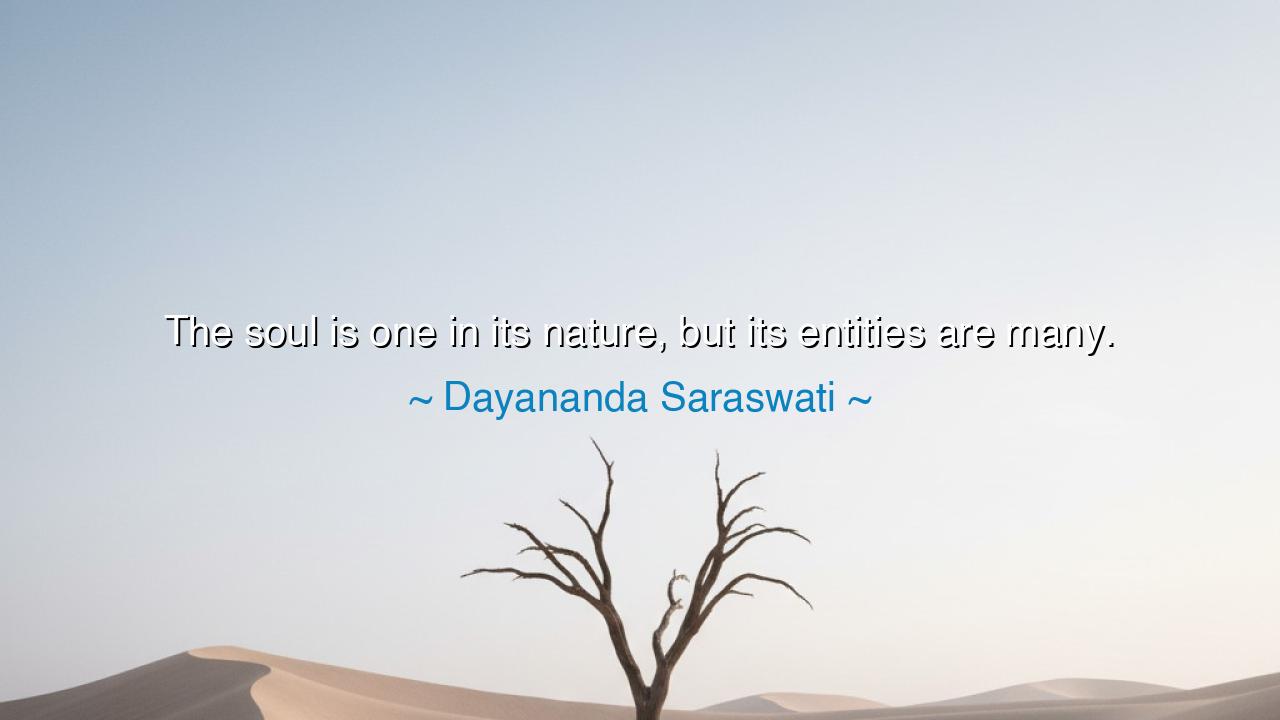
The soul is one in its nature, but its entities are many.






Hear the profound words of Dayananda Saraswati: “The soul is one in its nature, but its entities are many.” In this saying, the sage reveals a mystery of existence: that the soul, eternal and indivisible in essence, manifests itself in countless forms, expressions, and capacities. The soul is like a flame—single in nature, yet capable of lighting many lamps. Each lamp shines with its own brightness, its own shape of glass, but all are born of the same fire. Thus, the essence of life is unity, yet its expressions are manifold.
To say the soul is one in its nature is to affirm that at its core, every being carries the same spark. Whether in king or beggar, saint or sinner, the eternal flame is of one kind—pure, immortal, untainted by the shadows of the world. But when Saraswati declares that its entities are many, he acknowledges the diversity of mind, body, personality, and action through which that one essence reveals itself. Just as sunlight refracts into a spectrum of colors when it passes through crystal, so the soul refracts into the many hues of human experience.
This truth has echoed through the wisdom of many ages. Recall the Bhagavad Gita, where Krishna declares that the soul cannot be cut, burned, or destroyed—it is one, eternal, and indestructible. Yet, at the same time, souls appear in endless numbers, each walking its own path, bearing its own burdens, singing its own song. Unity at the root, multiplicity in the branches—this is the paradox Saraswati unveils.
Consider the life of Gautama Buddha. He attained enlightenment and spoke of nirvana, the end of illusion. Yet his disciples, though all touched by the same teaching, each carried a different light to the world. Ananda, his cousin, remembered the teachings with precision; Mahakashyapa embodied silent transmission; Ashoka, centuries later, carried the Dharma into kingdoms. One truth, one soul-nature—but many entities, many expressions. The soul’s oneness does not erase diversity; it sanctifies it.
The meaning is clear: though we appear different in body, thought, and destiny, our essence is of one kind. To forget this is to fall into pride, envy, hatred, and division. To remember it is to live with reverence—for the stranger, the neighbor, the enemy even—for all are carriers of the same eternal flame. The many entities of the soul are not to divide us, but to enrich us, as instruments in a symphony enrich the melody while playing in harmony.
The lesson for us is to live with both awareness of unity and respect for diversity. Strive not to erase differences, nor to despise them, but to see them as many rivers flowing from one source. In your dealings with others, remember that behind the face, behind the voice, behind the deeds, lies the same immortal essence that lives within you. And within yourself, remember that your many thoughts, desires, and experiences are not contradictions, but expressions of one underlying spirit.
So I say to you: honor the oneness of the soul, but cherish also its many entities. Do not cling to the illusion that separateness is ultimate, nor deny the richness of individuality. Walk as one who knows that life is both unity and multiplicity, flame and sparks, root and branches. For in this balance lies wisdom, and in this wisdom lies peace. And thus the teaching of Saraswati becomes a guiding star: to see the eternal in all, and the many as the play of the One.






AAdministratorAdministrator
Welcome, honored guests. Please leave a comment, we will respond soon